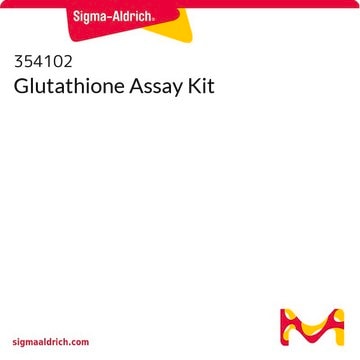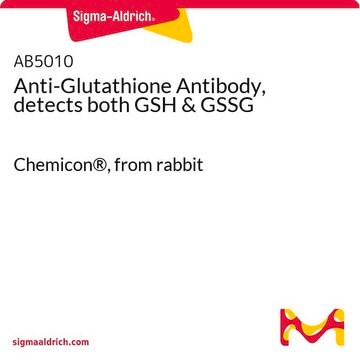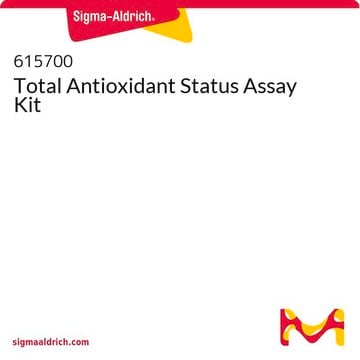CS1020
Glutathione Assay Kit, Fluorimetric
sufficient for 200 multiwell tests
Synonym(s):
GSH Quantification Kit
Sign Into View Organizational & Contract Pricing
All Photos(2)
About This Item
Recommended Products
usage
sufficient for 200 multiwell tests
Quality Level
shipped in
wet ice
storage temp.
−20°C
Gene Information
human ... GSTA4(2941)
Application
Glutathione Assay Kit, Fluorimetric has been used in intracellular thiol assays and in the measurement of hepatic glutathione in rats.
The Glutathione Assay Kit, Fluorimetric includes all the reagents required for fast and easy measurement of reduced glutathione in cell or tissue extracts or directly in growing cells. Staurosporine is supplied with the kit to enable induction of apoptosis in cells. Since the amount of reduced glutathione in staurosporine-induced cells is significantly lower than in non-induced cells, this can serve as a control system.
Biochem/physiol Actions
Glutathione (GSH) acts as a cofactor for several antioxidant enzymes. It helps in the regeneration of vitamins C and E. It regulates cellular proliferation and apoptosis. GSH is important for mitochondrial functioning and the maintenance of mitochondrial DNA (mtDNA). Mutations in this gene is associated with Alzheimer′s, Parkinson′s and Huntington′s diseases.
Reduced glutathione (GSH), a tripeptide (γ-glutamyl-cysteinylglycine), is the major free thiol in most living cells and is involved in many biological processes such as detoxification of xenobiotics, removal of hydroperoxides, and maintenance of the oxidation state of protein sulfhydryls. It is the key antioxidant in animal tissues. Glutathione is present inside cells primarily in the reduced form (90-95% of the total glutathione). The remainder is present in the oxidized form (glutathione disulfide, GSSG). Intracellular GSH status appears to be a sensitive indicator of the overall health of a cell and its ability to resist toxic challenge. High levels of GSH in the cell may indicate pathological changes.
Analysis Note
The kit assay utilizes a thiol probe (monochlorobimane), which can freely pass through the plasma membrane. The free, unbound probe shows very little fluorescence, but when bound to reduced glutathione in a reaction that is catalyzed by glutathione S-transferase (GST), it forms a strongly fluorescent adduct.
Kit Components Only
Product No.
Description
- Assay Buffer 50 mL
- Substrate Solution 1 mL
- Lysis Buffer 10x 1.5 mL
- Glutathione S-Transferase 1 mL
- Staurosporine Ready Made 100 μL
- Glutathione, reduced 300 mg
related product
Product No.
Description
Pricing
Storage Class Code
10 - Combustible liquids
WGK
WGK 3
Flash Point(F)
Not applicable
Flash Point(C)
Not applicable
Certificates of Analysis (COA)
Search for Certificates of Analysis (COA) by entering the products Lot/Batch Number. Lot and Batch Numbers can be found on a product’s label following the words ‘Lot’ or ‘Batch’.
Already Own This Product?
Find documentation for the products that you have recently purchased in the Document Library.
Customers Also Viewed
Mehdi Hichor et al.
Scientific reports, 8(1), 2524-2524 (2018-02-08)
Reactive oxygen species (ROS) modify proteins and lipids leading to deleterious outcomes. Thus, maintaining their homeostatic levels is vital. This study highlights the endogenous role of LXRs (LXRα and β) in the regulation of oxidative stress in peripheral nerves. We
Preparation of ZnO/Ag nanocomposite and coating on polymers for anti-infection biomaterial application
Sadeghi B.
Spectrochimica Acta. Part A, Molecular and Biomolecular Spectroscopy, 118, 787-792 (2014)
Elzbieta Zieminska et al.
Neurochemical research, 42(3), 777-787 (2016-10-09)
Using primary cultures of rat cerebellar granule cells (CGC) we examined the role of calcium transients induced by tetrabromobisphenol A (TBBPA) in triggering oxidative stress and cytotoxicity. CGC were exposed for 30 min to 10 or 25 µM TBBPA. Changes in intracellular
Megan M Blewett et al.
Science signaling, 9(445), rs10-rs10 (2016-09-15)
Dimethyl fumarate (DMF) is an electrophilic drug that is used to treat autoimmune conditions, including multiple sclerosis and psoriasis. The mechanism of action of DMF is unclear but may involve the covalent modification of proteins or DMF serving as a
Shayne Squires et al.
The open biochemistry journal, 7, 54-65 (2013-08-07)
We investigated whether a cell-penetrating peptide linked via a disulfide bond to a fluorophore-labeled cargo peptide can be used to interrogate changes in cellular redox state. A fluorescence resonance energy transfer (FRET) pair was constructed so that the cargo peptide
Our team of scientists has experience in all areas of research including Life Science, Material Science, Chemical Synthesis, Chromatography, Analytical and many others.
Contact Technical Service








